Raising Water Consciousness through
World’s Biggest Photo Exhibition and
Largest collection of Photo Stories on Water
Photo Stories | Water and Culture
Water and Religion: The Way Forward for Strengthening their Connection
Nandita Singh and Om Prakash Singh
15 October, 2017
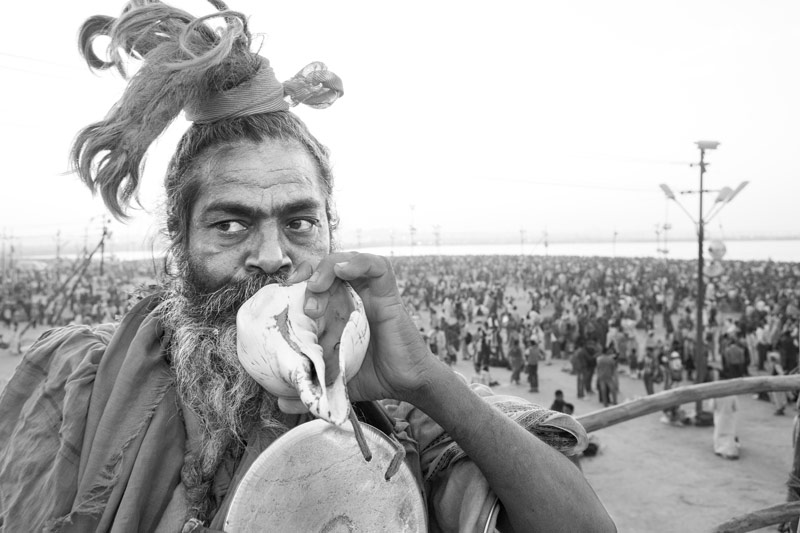
Water and religion share an intricate relationship. The nature of their connection and its relevance for society in India has been exemplified in the story dated 16 August 2017. However, in contemporary times, this intricate relationship is being seriously challenged, ultimately disrupting the 'water-religion-society continuum' in multiple ways. These challenges and their implications for society and environment in India have been presented in the story dated 16 September 2017. In this context, there is undoubtedly an urgent need to strengthen the connections between water and religion so that not only are water-related religious beliefs and practices supported and perpetuated, but more importantly, water sustainability in general is promoted, in turn enabling sustainable development. This photo story aims to delineate a way forward whereby the connections between water and religion can be strengthened, primarily drawing upon the context of Hinduism. This entails a multi-pronged approach and requires concerted efforts on part of all water stakeholders. The approach requires actions at two levels, namely pragmatic and ideological. On the pragmatic side, there is need to immediately put a stop to all acts of pollution that degrade sacred water bodies whether by individuals, municipalities or businesses. Further, polluted sacred water bodies must be cleaned up and the cleanliness regularly maintained, large hydropower projects on sacred rivers be discontinued, diverted sacred river courses be restored, encroachment in sacred water bodies removed, rooted public campaigns launched in protest against degradation of sacred water bodies, large-scale efforts made to rejuvenate the dead and depleted water bodies that are ritually valued, and the upkeep and maintenance of all water bodies be ensured. At the ideological level, there is need to enhance and perpetuate the religious values concerning water using different means such as awareness campaigns, public speeches and presentations by religious leaders, value-based participatory learning for children, as well as public veneration at sacred sites adjoining water bodies. The actions on the pragmatic side will directly help restore the qualitative and quantitative health of degraded sacred water bodies, thereby enabling unhindered perpetuation of religious beliefs and practices connected to water. The actions on the ideological side will promote and perpetuate respect for the religious values attached to water, arouse the consciousness in water users to reflect upon their actions especially those connected to sacred water bodies, initiate attitudinal and behavioral changes in this regard, and help transform them into more responsible water stakeholders who can promote sustainable water resources management. This, in turn will support water sustainability, enhancing availability of clean and sufficient water for diverse human and ecological uses. The title photo depicts a saint blowing conch at the confluence of rivers Ganga, Yamuna and the mythical Saraswati at Prayag, Allahabad in Uttar Pradesh during Kumbh. Blowing of the conch in Hinduism symbolizes the dawn of a new beginning which in this case is the start of a new way forward for strengthening the connection between water and religion and therefore sustainable water resources management.
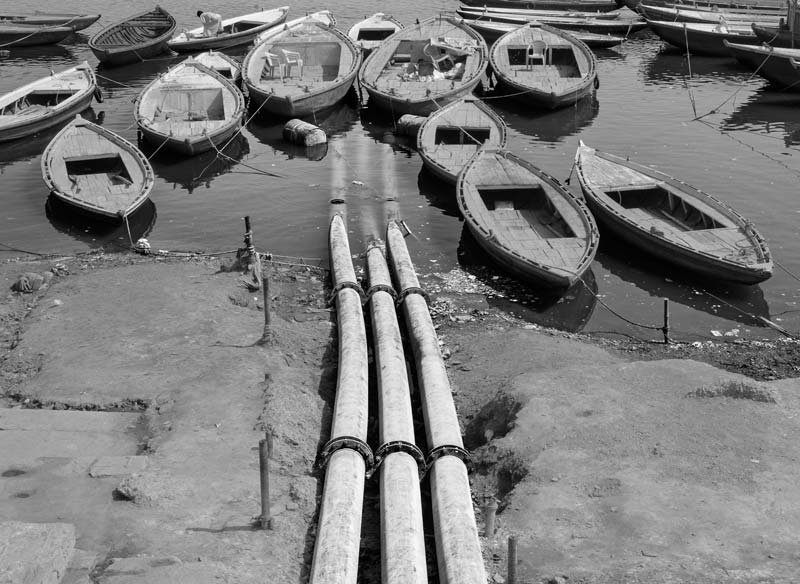
Untreated municipal sewage being discharged into river Ganga near Dr. Rajendra Prasad Ghat in Varanasi, Uttar Pradesh
Pollution of sacred water bodies is a huge challenge which needs to be addressed in order to strengthen the connection between water and religion. Ganga is the most important sacred river of India but also the fifth most polluted river in the world. According to recent government estimates, nearly 4.8 billion liters sewage and over 500 million liters of industrial effluents is dumped into the river every day from over 120 cities and towns located along its course, at least three quarter of which is untreated. In Varanasi, the spiritual capital of India situated on its banks and visited by millions of pilgrims every year for ritual bath and other religious duties, the state government and municipal authorities have been insensitive to the cause. They have ignored the implications of the river's pollution for religious beliefs and practices, silently allowing discharge of untreated sewage and industrial effluents into the river through diversion pipes and open drains. It is high time for the authorities as well as all water stakeholders to awaken and take concrete steps to immediately stop further pollution of Ganga as well as other sacred rivers in the country. In fact, the government should itself first take up the responsibility of respecting and caring for the sacred water bodies before trying to sensitize or hold only public responsible.
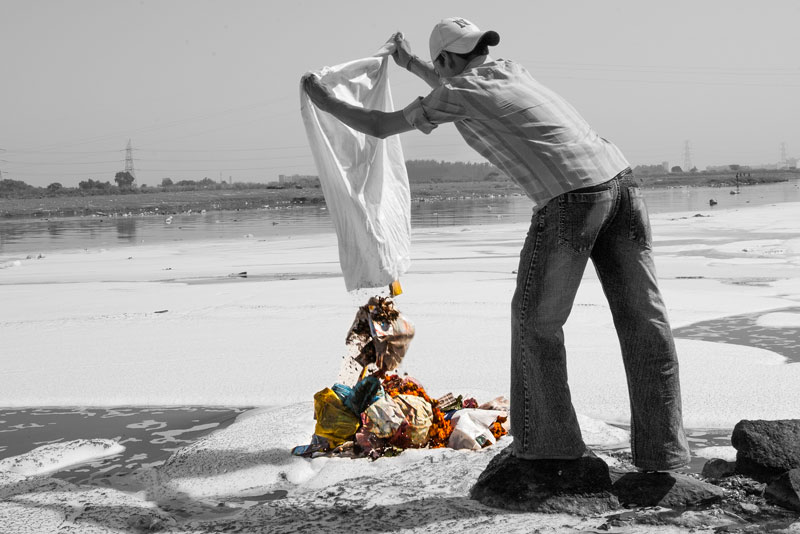
Disposing solid waste remaining from religious rituals in sacred river Yamuna in South-East district, National Capital Territory of Delhi
Yamuna is an important sacred river in northern India and a main tributary of river Ganga. The river is revered as a Hindu goddess but today this sacred river is in a deplorable state, described as 'dead' or merely a 'drain' especially around Delhi and downstream. While discharge of millions of liters of untreated and partially treated municipal sewage and industrial wastewater on a daily basis into the river is commonly regarded as the most important reason, what is often overlooked is the seriousness of the practice of dumping of solid waste remaining from religious rituals such as flowers, banana leaves, mango leaves, ashes, incense packets, coconut, used plastic bags etc. into Yamuna and sacred water bodies as a virtuous duty. This act of the devotees brings tons of solid waste into sacred rivers, leading to very high level of pollution. What the devotees don't realize is that throughout the year uncountable number of religious festivals and occasions are celebrated across the country at individual and collective level. If everyone would start disposing the ritual remains from each such occasion into sacred water bodies then the extent of pollution would be immense, rendering these unusable for further religious observances including ritual bathing. There is need for the public to be sensitized to the fact that since this supposedly virtuous act amounts to disrespecting and degrading sacred water bodies, it is actually an act of sin. There is need for deep attitudinal change in the devotees based on the belief that blessing of the supernatural would be received if religious waste is instead considered as waste and disposed appropriately rather than polluting and killing the sacred water bodies.
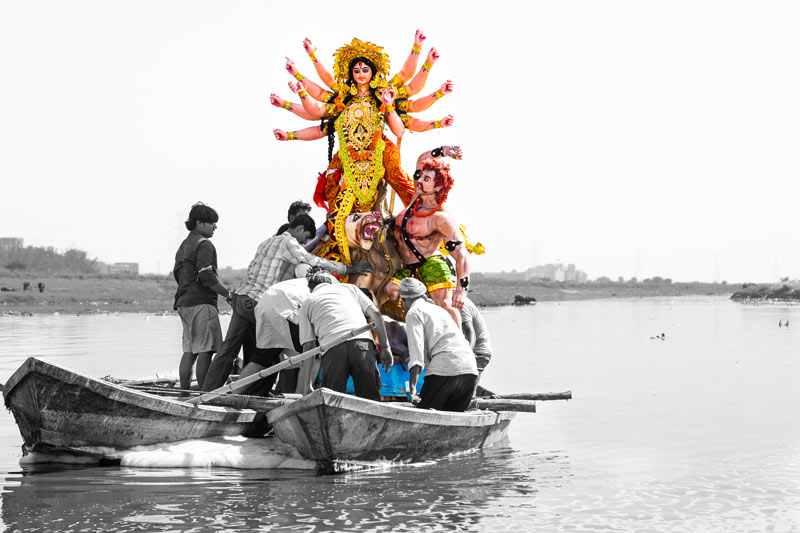
Idol of goddess Durga being immersed in river Yamuna in South-East district, National Capital Territory of Delhi
While numerous secular domestic and productive activities cause pollution of sacred water bodies that make devotees compromise their religious sentiments, certain religious activities themselves contribute similarly. Idol immersion is a religious activity which significant degrades the quality of the receiving waters in several ways. In most cases, idols are made of non-biodegradable materials like Plaster of Paris (PoP), plastic, and thermocol, and use iron rods and bamboo poles. These are colored with synthetic paints which contain heavy metals like copper, zinc, chromium, cadmium, nickel, lead, iron, arsenic and mercury. These paints are not only non-biodegradable, but are neuro- and nephrotoxic and some even carcinogenic. In addition, materials like synthetic dress material, straw, jute, flowers and leaves used in decoration and worship are also immersed along with the idols. There is need to bring about changes in the practice of idol making and their immersion so that these ill-effects can be minimized. This will require concerted efforts on part of citizens as the participants in immersion activities, the idol makers, as well as authorities who should be responsible for generating awareness in society as well as regulating the activities effectively.
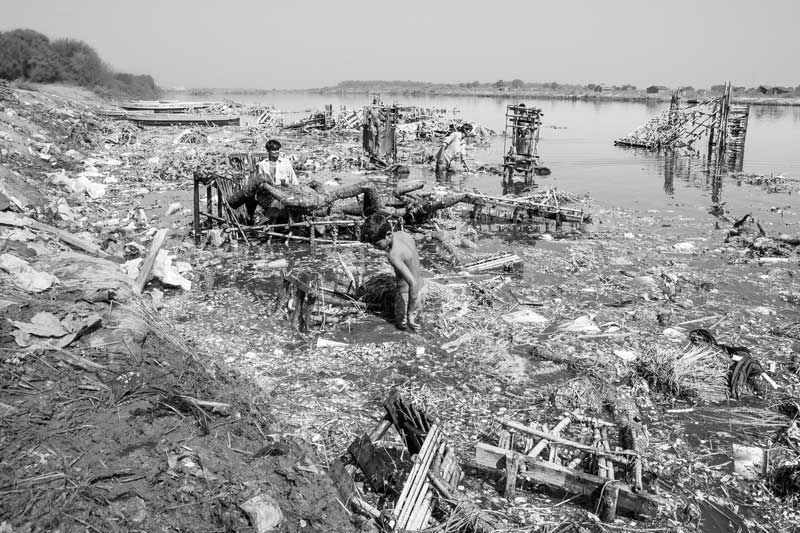
The scene at Yamuna banks after immersion of Durga idols in Central district, National Capital Territory of Delhi
Every year millions of idols are immersed in rivers, tanks, ponds, sea and other sacred and secular water bodies after religious celebrations like Ganesh Chaturthi and Durga Puja to name a few. Consequently, large quantities of insoluble inorganic as well as organic material are added to these water bodies, as evident in the photo above. In 2010, the Central Pollution Control Board produced detailed guidelines regulating idol immersion in the country so as to minimize the negative environmental effects. For example, it stipulates the need to encourage making of idols using non-baked, quick-dissolving clay that are either unpainted or painted with water soluble and nontoxic natural dyes. With respect to river Yamuna, in 2015 the National Green Tribunal banned immersion of idols made from non-biodegradable material like PoP or plastic. However, implementation of these guidelines has been poor. Since immersion of idols into water bodies is a common practice all over India, there is need to effectively implement such guidelines and sensitize citizens about their environmental responsibilities. In 2017, at one of the prime Durga Puja locations in Delhi, an eco-friendly immersion was organized by digging a pond in the vicinity and immersing the idols there. The pond is to be later used as a compost site, and the frame of the idols and the stage will be returned to the artists for reuse. Such efforts need to be widely publicized in the country and supported so that not only spiritual benefits of these festivals are drawn by the devotees but water resources remain protected.
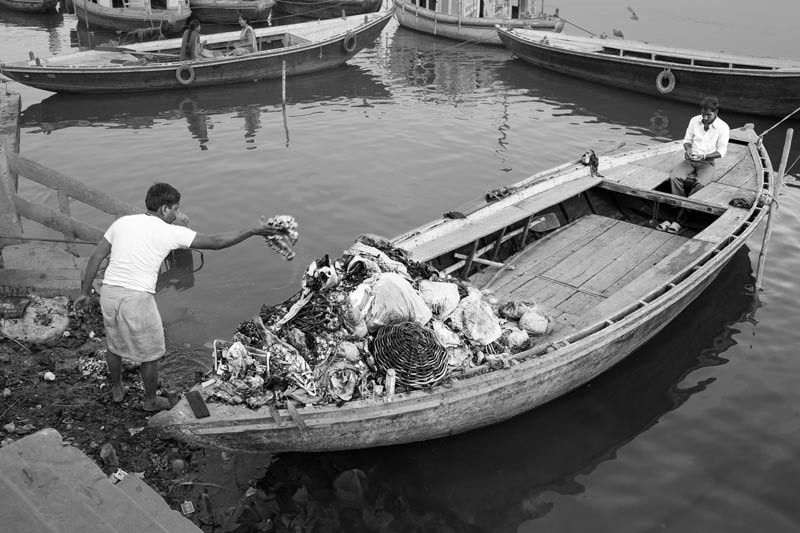
Cleaning of river Ganga near Dashashwamedh Ghat in Varanasi, Uttar Pradesh
On the Ghats along the banks of sacred rivers, hundreds and thousands of devotees perform worship of the river and other deities and also follow various ritual observances. Ghats are embankments with constructed steps which can be used for descending down to the waters conveniently to perform activities in the river. As a part of worship and ritual observances, flowers, leaf plates, earthen lamps, cotton wicks etc. are left to drift in the river. In addition, many devotees cling closely to the belief that immersing remains from ritual observances performed elsewhere into sacred water is a religious duty. Besides, where cremation grounds are also located along the river banks, ashes and other waste from the cremation process get released into the rivers. Consequently, a lot of solid waste including plastic bags accumulates near the Ghats in the water on a daily basis which is an important cause of river pollution. While there is need to sensitize all worshippers and believers not to indulge in such polluting activities, it is not easy to get foolproof results as attitudinal change on this front may be difficult and slow. In such a situation it is important for the responsible agencies to simultaneously arrange for regular cleaning of the river particularly near the Ghats so that the organic waste can be prevented from decaying in the water and the inorganic waste like plastics from choking the water surface or settling at the bottom. Such regular cleaning should be organized at all sacred rivers, tanks and other water bodies.
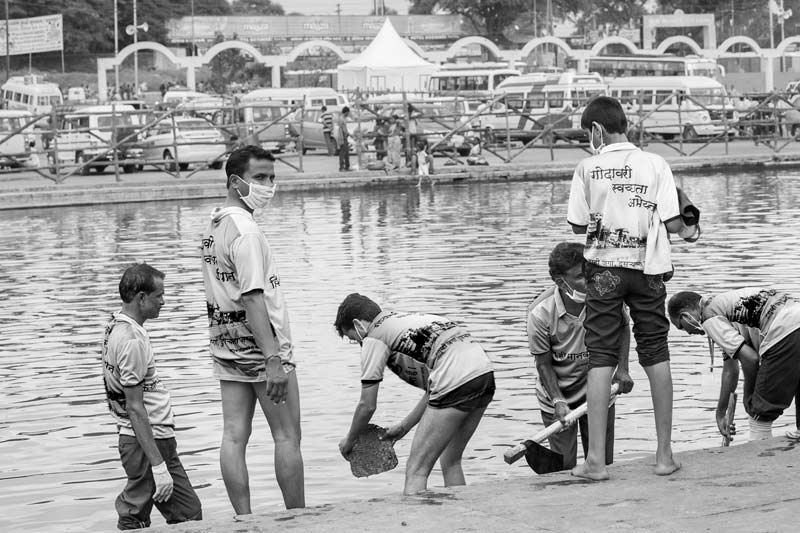
Volunteers cleaning the Ghats on the banks of river Godavari during Kumbh in Nashik, Maharashtra
Cleaning of the polluted sacred rivers needs to be combined with cleaning of the Ghats located along their banks. Since Ghats are regularly used by people round the clock, in the absence of proper arrangements for solid waste disposal, these often tend to accumulate garbage, including organic remains from ritual activities such as flowers, as well as other items like used plastic bags. If Ghats are not cleaned regularly, the solid waste accumulates on the steps and ultimately gets swept down into the river, adding to the pollution load. The photo above portrays the 'Godavari Cleaning Campaign' organized by Jagadguru Narendracharyaji Maharaj on the Ghat of river Godavari during Kumbh where his disciples offered voluntary service. The campaign ensured that the Ghats and their surroundings remained properly clean to maintain the sanctity of this great religious occasion. For reducing the pollution load in sacred rivers on a daily basis, authorities need to learn the positive lesson from such arrangements and implement Ghat cleaning as a regular activity so that solid waste and other contaminants do not end up polluting the river. Further, such voluntary activities organized by religious leaders and the public are a welcome step and should be promoted and similarly adopted elsewhere, rather than depending solely on government authorities.
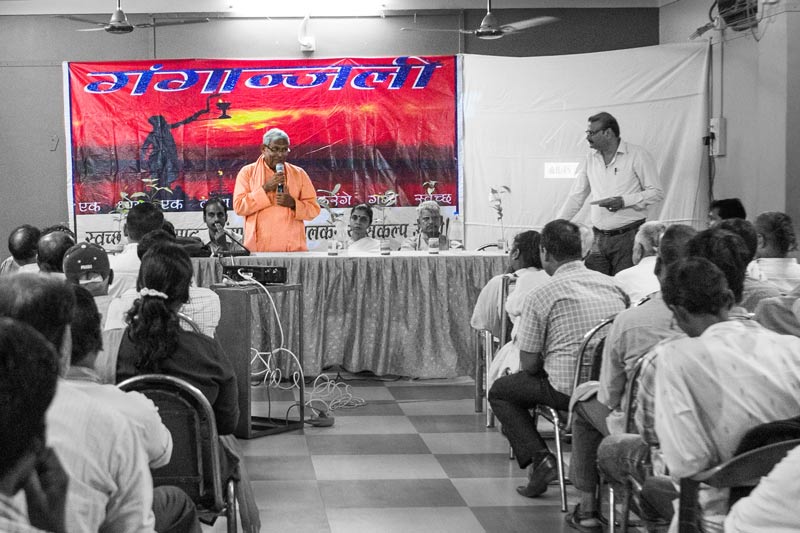
Ganganjali - a citizens' forum for protection and upkeep of river Ganga in Munger, Bihar
'Ganganjali' (Tribute to Ganga) is a citizens' forum started in Munger which focuses on protection and upkeep of river Ganga on the banks of which this city is situated. The forum is the brainchild of a prominent social activist Kishore Jaiswal and under his able guidance the youth of Munger are constantly striving to discourage the use of plastic at temples and religious places along the banks of the river, and promoting its replacement by ecofriendly options like paper packets, jute bags, leaf plates and containers through the involvement of religious leaders, priests, shopkeepers and the people. Besides they also focus on proper solid waste management at temples and religious places. These actions are seen as important for the health of river Ganga because Munger is an important Hindu religious center always visited by large number of devotees. Actions by the devotees – local as well as from outside –causes unintentional littering of plastic and other religious waste on the premises which ultimately gets swept down into the river causing pollution. At one of the public meetings organized by Ganganjali, prominent religious leaders, priests, members of local administration, journalists, merchants, teachers, academicians, and many other local residents were invited to discuss on this issue and define a concrete way forward. The meeting ended with a vow to immediately put a stop to use of plastic in the temple complexes and other religious places along the river banks and install trash cans at these sites, together with their regular cleaning through participation of the different stakeholders. Initiatives like Ganganjali are a need of the time because protection and upkeep of the sacred and secular water bodies in the country requires the sensitization and participation of all stakeholders and cannot be seen as merely a government responsibility. There is need to promote and scale up such efforts because citizens' conscious involvement can go a long way in enhancing the feasibility and sustenance of the actions.
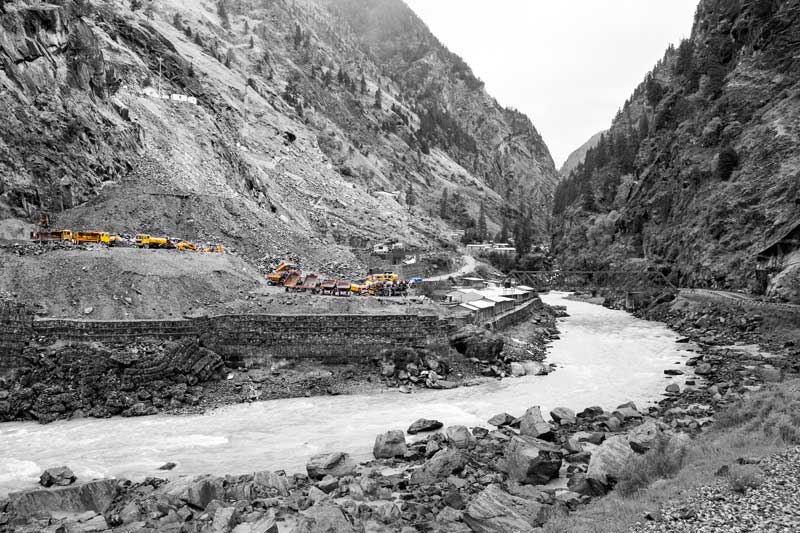
A suspended hydropower project planned on river Bhagirathi in Uttarkashi district, Uttarakhand
River Bhagirathi, which originates at the Gangotri glacier, is the main source of Ganga, the most sacred river of India. However, in recent decades this river has come to be dammed, diverted and exploited at several places along its course primarily for hydropower production and supply of irrigation and drinking water to Delhi and adjoining areas. This has not only brought environmental degradation in the upper reaches of the river and displaced large populations, but equally importantly, the religious sentiments of millions of people have been hurt due to changing of the nature, character and flow of the river. Several protests have been organized by action groups that aim to protect river Ganga from such onslaughts. For example, Prof. G. D. Agrawal alias Swami Gyan Swaroop Sanand, an eminent scientist-turned-saint and environmental activist engaged in 'fasting unto death' 4 times since 2008 seeking to prevent the construction of hydroelectric power projects on the Himalayan source rivers of Ganga. He was supported by several others like social activist Anna Hazare, and the 'Waterman of India' Rajendra Singh. As a result of such serious protests and fasts, the government was forced to cancel some of the dam projects on the river's upper reaches, of which one is depicted in the above photo at Loharinag-Pala on Bhagirathi. This 600 MW project involved construction of a 12 km long tunnel passing through left side hills of the river and drying up of a river stretch of 16.2 km. Given this background, and the extreme level of protests, it is obvious that there is need for government to be more sensible and refrain from damming, diverting and exploiting sacred rivers and its decisions in this regard should not wait for such rigorous actions as 'fast unto death'. In order to fulfil people's needs for power and water, the government needs to develop other more sustainable means, and allow the Ganga and other sacred rivers to flow along their natural course.
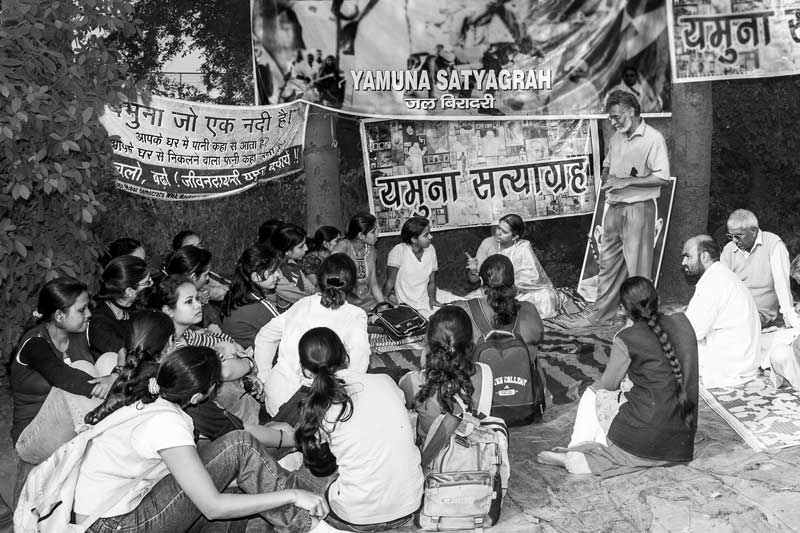
A public campaign in progress to save sacred river Yamuna from encroachment in East Delhi district, National Capital Territory of Delhi
Many sacred rivers, tanks, ponds and other water bodies in India are dying. Their beds have been grossly encroached for constructing buildings, roads, bridges etc.; their water has been diverted for hydropower generation, and overexploited for irrigation, industrial and urban water supply; and their nearly dry beds are instead converted into drains that receive the city sewage and industrial wastewater. Death of the sacred water body not only disturbs religious beliefs and practices but also destroys water sources for the catchment communities and connected ecosystems, and degrades groundwater quantity and quality around. In such situations, where sacred water bodies suffer due to administrative neglect, political despise and large-scale misuse and mismanagement, protests and campaigns emerge as the only way out to attract attention of the authorities, raise mass awareness about the issues and initiate local actions to democratically influence decisions by acting as pressure groups. These can be launched by non-governmental organizations (NGOs), civil society organizations and other action groups together with active participation of citizens. The photo above depicts a protest campaign called 'Yamuna Satyagraha' launched in 2007 with the aim of saving the sacred river Yamuna in Delhi from encroachment. The campaign was launched by Jal Biradari (The Water People) under the leadership of Rajendra Singh, and was supported by school children, college students, concerned citizens of Delhi, local farmers, several environmental organizations and noted personalities like Vandana Shiva. The purpose of the campaign was to generate awareness towards protection and rejuvenation of river Yamuna and influence decision-makers to withdraw construction of the Commonwealth Games village in the river bed.
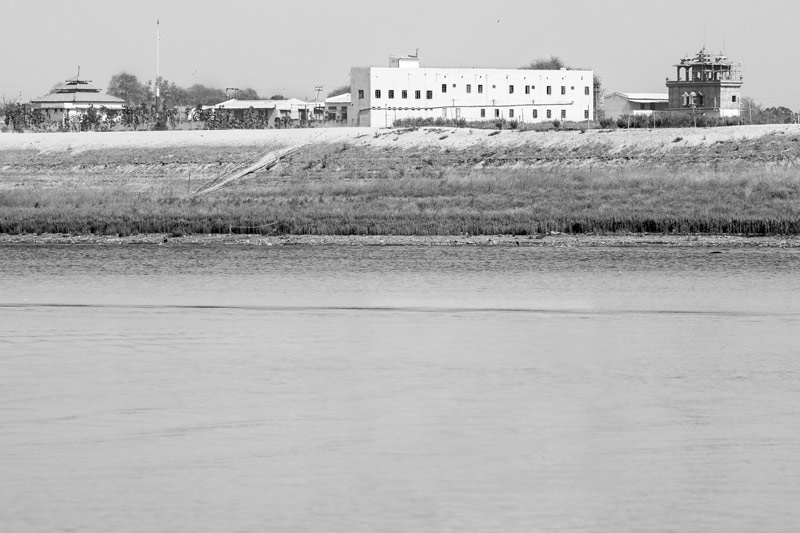
Encroachment in the bed of river Ganga in Varanasi, Uttar Pradesh
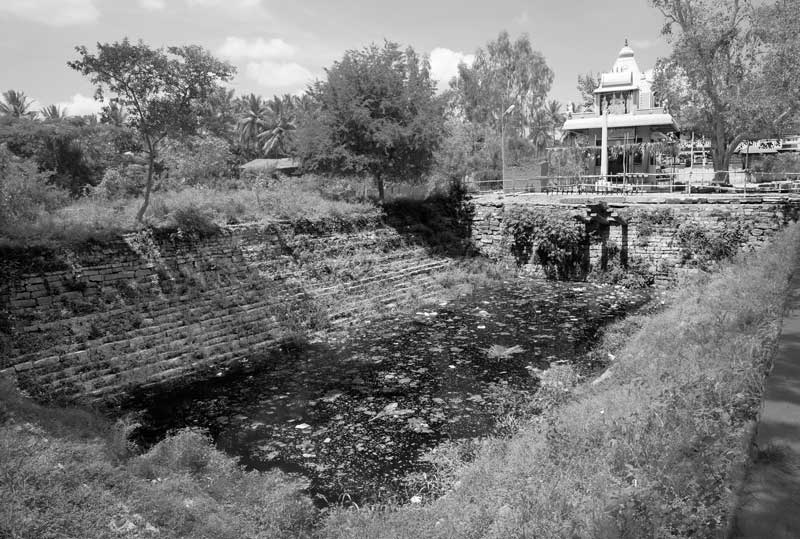
A sacred tank lying in a dilapidated condition in Chikkaballapur district, Karnataka
Sacred tanks have existed in association with temples in many places, where these have traditionally served varied religious as well as secular functions. However, in present times, a large number of sacred tanks lie in a dilapidated state. At many places, the catchment of the tank has been encroached, the inlets and outlets are blocked, the bed is heavily silted, or even these tanks are used for washing and bathing by local residents using soap. Worst of all, sometimes even garbage is dumped in and around the tank. As a result these are either drying up or else the water is highly polluted, making these non-usable for sacred and secular purposes. Most importantly, since these also acted as percolation tanks, their degeneration has led to contamination and lowering of groundwater ltable, affecting safe water availability for local residents. The degraded sacred tank shown in the photo above was once rejuvenated by a NGO called SWARAJ, but the rejuvenation failed to be sustained and it again lies in a sad state today. In order to strengthen the bond between water and religion and foster water sustainability in general, there is an urgent need to rejuvenate these degenerated water bodies but equally important is the need to ensure their regular upkeep and maintenance so that these can continue to serve their ritual and secular functions for society and environment. This will require concerted and sustained efforts on part of several stakeholders such as the temple authorities, local residents, local administration and even local NGOs and civil society organizations.
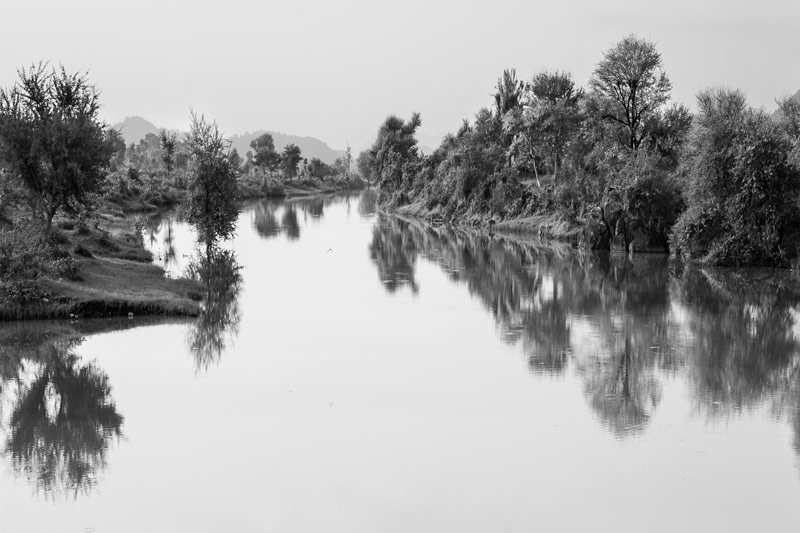
Rejuvenated Arvari river in Alwar district, Rajasthan
Since water has a sacred value attached to it and many water bodies have been considered sacred, rejuvenation of water bodies is a religious activity. According to holy scriptures, digging a well or a pond brings religious virtue, about which goddess Parvati is believed to have said that "One who digs a well where there is little water lives in heaven for as many years as there are drops of water in it. One large reservoir of water is worth ten wells". In this light, river rejuvenation is a highly virtuous act which has been undertaken by local communities in semi-arid Alwar district. They have revived 5 dead rivers, namely Arvari, Sarsa, Ruparel, Jahajwali and Bhagani-Tildeh, with support from the NGO Tarun Bharat Sangh (TBS) guided by Rajendra Singh. River Arvari had practically remained dry for over 60 years, except for a short monsoon trickle. Work in the direction of reviving Arvari started in 1986 and by 1994 it started flowing again. As a result of the virtuous act of river rejuvenation undertaken by the community, they have come to be blessed with water which has restored their lost livelihoods, enabled the practice of religion and culture, and ushered in prosperity. According to Rajendra Singh, the Arvari river, once considered lost, is now sacred for the local people, and many older residents request that their ashes be sprinkled over Arvari, instead of holy Ganga. Following the positive example of river restoration work in Alwar district, there is need to scale up such work to revive many other rivers, ponds and tanks inIndia which have either disappeared or are struggling to survive. This will help strengthen the bond between water and religion in multiple ways.
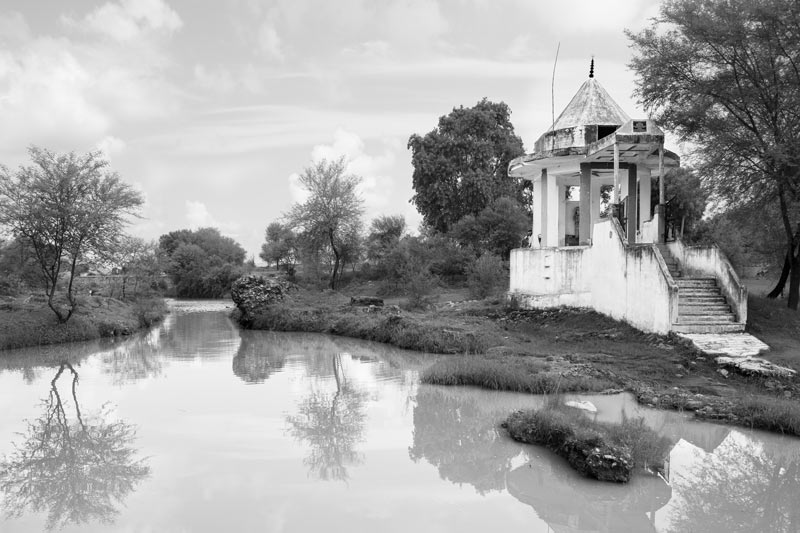
Arvari Mata ka Mandir - a temple dedicated to river goddess Arvari on the banks of rejuvenated Arvari river in Alwar district, Rajasthan
Various religious beliefs and practices concerning water represent ways to propagate discipline in society towards the protection and sustainable use and management of water resources for sacred and secular purposes, inculcated through the elements of 'respect' or 'fear' with regard to the supernatural. Construction of temples dedicated to river gods and goddesses or water deities helps this process primarily through inculcation of these emotions. Arvari is a small river in terms of its length and volume, but it is the lifeline of the villages located in its basin. Therefore, it is revered as goddess Arvari, locally referred as 'Arvari Mata' (Mother Arvari), and its water is considered sacred. The sacredness of the river is safeguarded through discipline in society. In order to promote societal discipline whereby the water users would respect her blessings and refrain from destructive acts, a temple dedicated to river goddess Arvari has been constructed on the banks of the river. Local residents offer prayers and express gratitude and reverence to the river at the temple. Construction of places of worship close to water bodies in general should be adopted as a good way to impart sacredness to them, thereby enhancing the possibility of its better care and management.
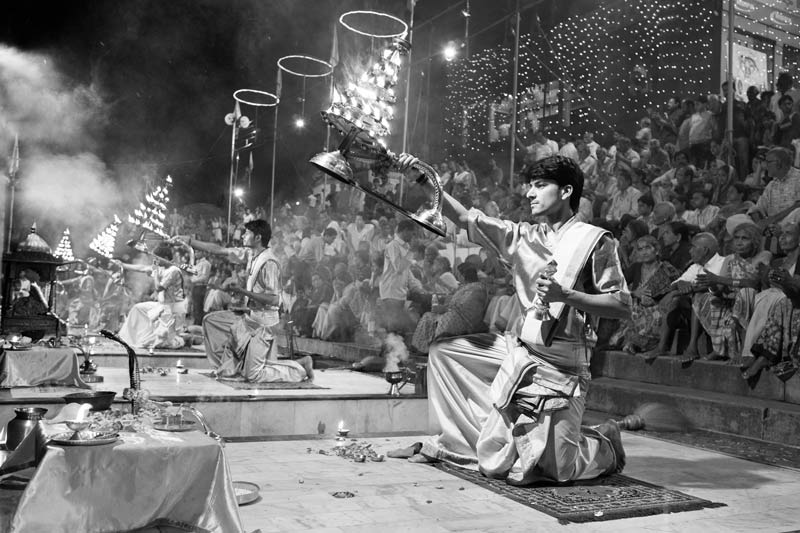
'Ganga Aarti' at Dashashwamedh Ghat in Varanasi, Uttar Pradesh
Since Ganga is not just considered as a river in India, but as Divine Mother, special prayer in the form of 'Aarti' is offered to her everyday at a number of religious centres situated along its course, such as Rishikesh, Haridwar, Prayag (Allahabad) and Varanasi. At Varanasi, it is performed at two places, namely, Dashashwamedh Ghat and Dr. Rajendra Prasad Ghat. Though the exact date of origin of this tradition is not known, many devotees believe that it may be thousands of years old. Aarti is performed using lamps, incense, bells, flowers and various other ritual objects. Most commonly, lamp & incense etc. are held by the priest in the hand and moved in circular motions in front of the river, accompanied by chanting of hymns and singing of devotional songs by the gathering in praise of the river goddess. At Haridwar before the actual ritual starts, the priests ask the attending devotees not to pollute river Ganga which people promise by raising both hands. Other sacred rivers are also similarly venerated, for example, Godavari at Nashik, Kshipra at Ujjain, and Yamuna at Delhi. Aarti signifies a ritual that dispels darkness and involves expression of a wide range of emotions including devotion, respect, gratitude or thanksgiving to a particular spiritual being, in this case the river. Consequently, river Aarti has the potential to play an important role in initiating attitudinal changes among devotees regarding the value of sacred rivers and the importance of their blessings for society and nature. Given this benefit, there is need to propagate and publicize this ritual practice more widely so that larger masses can get sensitized towards the significance of sacred rivers. Further value may be added to the ritual by inclusion of the aspect of river preservation whereby the devotees can get further sensitized about their own roles in protection and upkeep of the river.
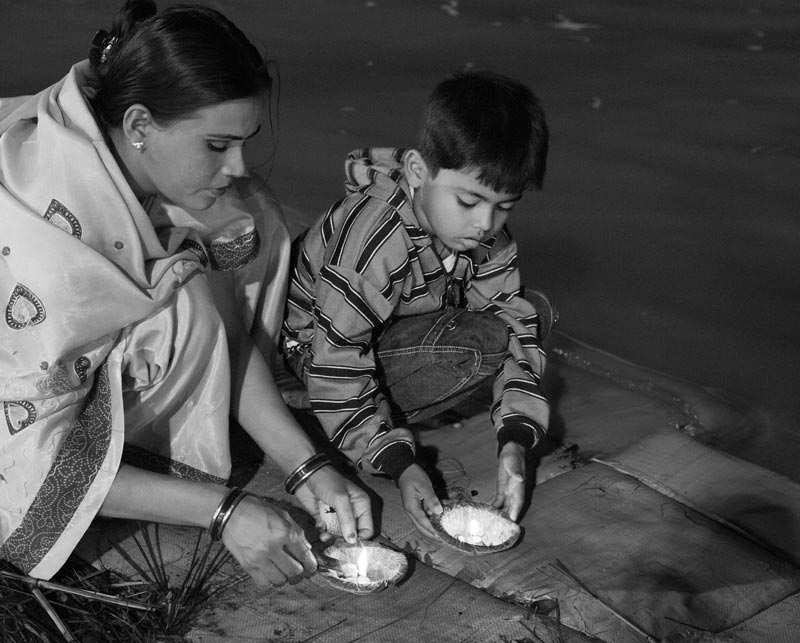
Learning to worship the water bodies at an early age at Triveni - the confluence of rivers Ganga, Yamuna and mythical Saraswati - in Prayag (Allahabad), Uttar Pradesh

A message for sensitizing masses on how stopping global warming is a reflection of religious duties towards nature in Haridwar, Uttarakhand
In Hinduism water is regarded as one of the five basic elements of nature, but global warming is affecting water quantity and quality through impact on the hydrological cycle in nature. While Information, Education and Communication (IEC) efforts aimed at improving water resources management in relation to religion is gaining ground, sensitization about global warming in the context of water and religion is still inconspicuous. Soham Baba, the Mahamandaleshwara of Juna Akhara, is a spiritual Hindu leader working relentlessly to raise awareness about global warming and its impacts, and sensitizing devotees about the religious duty to engage in actions for halting this process. Due to these efforts, he and his Mission were awarded the status of United Nation's Observer at the Framework Convention on Climate Change (UNFCCC) in 2011. The mission engages in displaying clearly worded IEC messages on the subject at religious congregations and other occasions, such as the one above which says "Stop global warming, Our duty is to save the five basic elements of nature". Soham Baba himself engages in addressing devotees to spread awareness and meeting environmentalists and politicians to discuss these issues. Given the successes of Soham Baba's endeavors, it emerges that engagement of religious leaders particularly in addressing issues concerning the connection between water and religion can go a long way in initiating effective solutions, particularly because such leaders often have large dedicated followings and command much respect in society. The government and other agencies can benefit immensely by engaging them as ambassadors in awareness campaigns and actions in this regard.
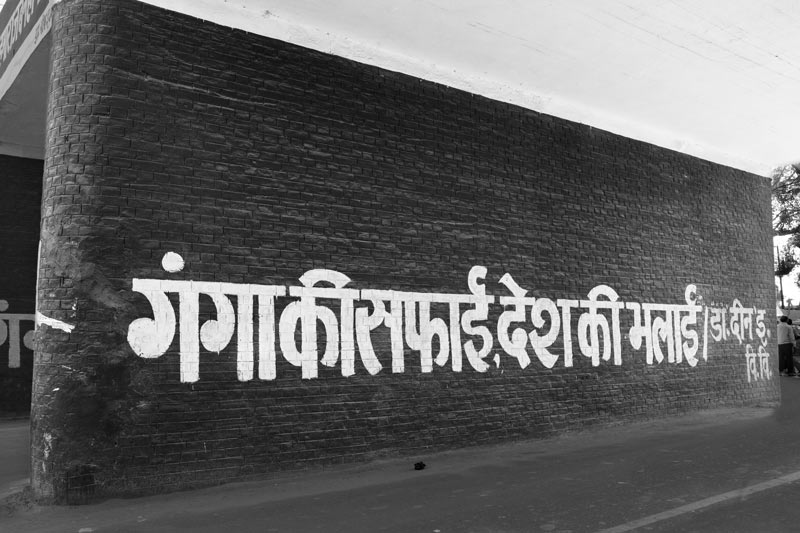
A message for sensitizing the public about the centrality and irreplaceability of river Ganga for India at Prayag (Allahabad), Uttar Pradesh
Strengthening the bond between water and religion is dependent on sustained changes in attitudes and behaviors among all water stakeholders. However, many water stakeholders are not aware about how their actions cause weakening of the bond and degrade water bodies, and consequently they continue with unhealthy practices. Some others may possess the knowledge but lack adequate will to bring about changes in their actions. This places the responsibility upon government and other agencies to generate large-scale awareness in society about the challenges facing the connection between water and religion, their implications for society and environment, and the expected role of different stakeholders in addressing these. This is possible through sustained IEC campaigns where there is need to develop effectively worded messages and use effective communication channels. Displaying effective messages at publicly accessible places, such as the one shown in the photo above, is a good effort in this direction. The message depicted in the photo says: "Cleaning of Ganga would bring goodness for the country". The use of public media such as the television and radio and the social media can also go a long way in generating awareness and sensitizing masses for appropriate action. There is need for agencies and concerned stakeholders to engage in massive IEC campaigns on the issue through different forums so that necessary attitudinal and behavioral changes can be encouraged.
Achieving water sustainability is the most pressing need of present times when degradation of water resources in terms of quality and quantity is emerging as an unsurmountable threat for society and environment. Though there exist several different approaches for sustainable water resources management, variously propagated by different stakeholders across the country (and the world), the role of religion in this endeavor is unparalleled yet little recognized. While water is often portrayed as a resource necessary for fulfilling religious functions in society, the role of religion in sustainable water resources management, which was in fact the first and most effective approach, has unfortunately come to be undermined in present times. Through generations, religion has played a vital role in inculcating values of respect and care for water and guiding society towards protecting this vital resource. It has helped instill discipline in society with regard to water use and management through respect or fear of the supernatural. These aspects have been elaborated in the photo story dated 16 August 2017. However, over time religion (as a whole) has come to be marginalized in society, turning water from a 'divine gift' to a 'commodity' which can be exploited, used and even traded in the market without any concern for the consequences of such acts on sustainability of water in terms of its quantity and quality. The centrality of religious beliefs and practices in sustainable water resources management holds true across the different religions practiced in India, with this series of photo stories highlighting the connection in the context of Hinduism. Given the importance of religion in upholding water sustainability, and the current attitudes of increasing disrespect, exploitation and even destruction of water resources in society, this photo story has delineated a conscious and well-planned approach based on actions at pragmatic and ideological levels aiming at strengthening the connection between water and religion. This will not only enhance water access for religious uses among the devotees, but most importantly, since water itself is a sacred resource and sacred water sources are also often the basis of water availability for other mundane sources and uses like drinking, production and nature, strengthening the bond of water with religion will emerge as an important means leading to sustainable water resources management. This path that has led to growth and development of civilization through ages needs to be revitalized today in an era where moralistic values and duties towards the life-giving element water are depreciated. This approach in turn will foster sustainable development and enable women, men and children to enjoy their human right to water, religion and culture, and also enhance their ability to enjoy several other rights such as health, education, and environment. Further, strengthening the connection between water and religion is all the more important in the current climate change scenario when the pressures on water in terms of quantity and quality are on the rise. Restoration and rejuvenation of sacred and other water sources and their effective care and management following the above actions is itself an approach for adaptation that can help tide over the crisis.